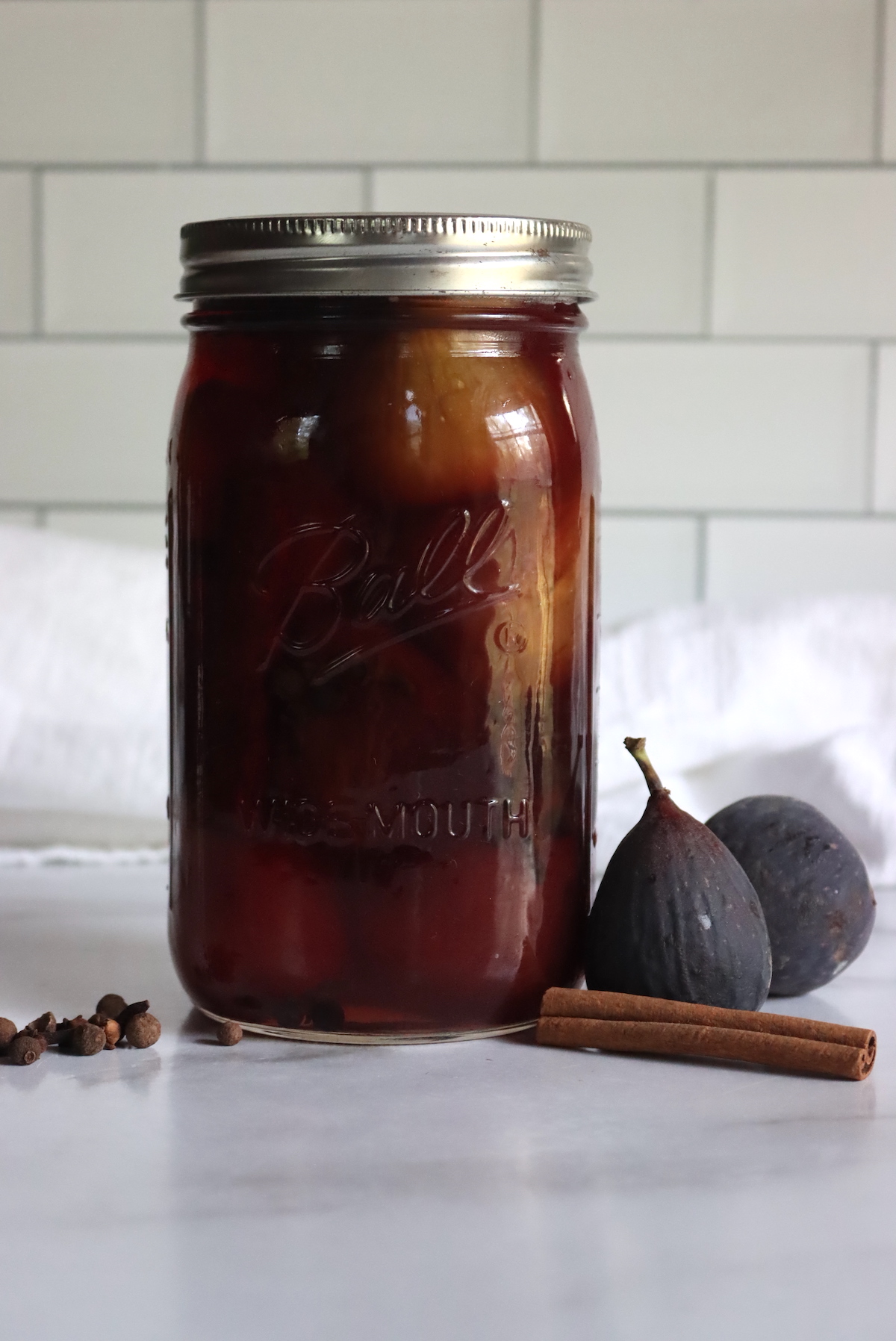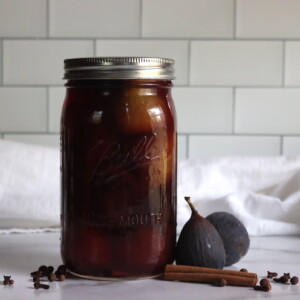This post may contain affiliate links. Please see our disclosure policy.
Pickled figs are a sweet old fashioned treat that brings back childhood memories for so many people. They’re made with warm spices of cinnamon and clove, and they taste like Christmas in a jar.

Pickled figs may sound a little strange, but they’re actually incredibly good.
Figs themselves are low in acid and high in sugar, meaning there’s not a lot of “tang” to balance out the intensely sweet flavors of fresh figs. Pickled figs, however, add in the tang of apple cider vinegar which really brings out the incredible flavor of figs.
There’s plenty of sugar in the recipe too, so it’s not exactly a mouth-puckering pickle experience. It’s more like fig candy almost, with the vinegar in there for both preservation and to add intrigue to what would otherwise be a uni-dimensional fruit.
What really puts pickled figs over the top is the warm spices, including cinnamon, cloves, and allspice.
Some people describe them as tasting like “Christmas in a jar,” which isn’t all that far off. Sweet fig-based candies and preserves are traditional at Christmas, and I imagine once you’ve made pickled figs, they’ll be on your holiday table every year.

Ingredients for Pickled Figs
I’m going to warn you here that making pickled figs is less about the ingredients, and more about the process. The vinegar to water ratio, sugar and seasonings are all important of course…but the magic happens in the process.
The basic ingredients to make 8 pint jars (of 4 quarts) are as follows:
- 4 quarts firm-ripe figs
- 5 cups sugar, divided
- 2 quarts water (8 cups)
- 2 cinnamon sticks
- 1 tablespoon whole allspice
- 1 tablespoon whole cloves
- 3 cups vinegar (5% acidity)
I know that some people have a tendency to read recipes and stop at the end of the ingredients list. I know this because I used to be one of these people!
Sometimes the process is important, and if you just put the figs in jar and make a brine with the rest of the ingredients (as you do with many other pickling recipes), things won’t come out right. And worse yet, the acidity from the vinegar may not fully penetrate the fig pickles and they might not be safely preserved.
Be sure to follow the process below.
How to Make Pickled Figs
To make pickled figs, the first step is either:
1) Peel the figs, or
2) Pour boiling water over unpeeled figs and let stand until cool, then drain.
Fig peels contain a sap that can be bitter, and soaking them in boiling water then discarding the water leaches out that sap. The skins are also a bit tough, and need a bit of softening so the pickling brine can get into the center.
You can peel the figs if they’re very firm and have thick peels. Some figs though, are more delicate and just don’t peel well. Test your figs, and if they’ll peel easily and hold together, go with that.
I’ve found that green figs tend to peel easily, especially when a bit under ripe. Black mission figs, on the other hand, are softer and have thinner skins. Those are best processed with skins on.
Either way, peeled or unpeeled and then soaked, that’s your first step.
Next, add 3 cups of sugar to 2 quarts (or 8 cups) of water and bring it to a boil on the stove in a stock pot or dutch oven. Note that this is not all the sugar in the recipe, and that there’s 2 more cups to be added later.
Place the prepared figs in the boiling syrup, and then turn down the heat to a simmer. Simmer gently for 30 minutes.
The figs will cook fully during this process, and start to turn a bit transparent. Try to cook them gently, and don’t stir them if possible so they hold together.
After 30 minutes of simmering in the syrup, add the final 2 cups of sugar along with 3 cups of vinegar. Stir gently to dissolve the sugar and distribute the vinegar.
Tie the spices into a small piece of cheesecloth and add them to the mix to infuse.
Return the mixture to a gentle simmer and cook until the figs turn transparent, about another 15 to 20 minutes. The sugar should keep them firm, but try to avoid stirring if you can. Keep the heat low so they don’t burn.
Turn off the heat and remove the spice bag.
***This step is important: Cover and let stand 24 hours in the syrup.***
You can leave them covered on the stove for 24 hours, or you can put them in the refrigerator. If you leave them out, don’t leave them more than 24 hours. In the refrigerator, you have more leeway and you can leave them 2-3 days before canning if you’re busy.
The next day, after 24 hours infusing, it’s time to get prepared for canning.
(You can also just pack into jars and store in the refrigerator for fridge pickles. They’ll keep for several months under refrigeration, but also take up fridge space in the process.)

Canning Pickled Figs
To can pickled figs, prepare a water bath canner and jars. Return the figs to the stove and heat to just barely simmering.
Pack the hot figs into hot jars, leaving 1/2 inch headspace. De-bubble jars, adjust headspace and wipe rims. Cap with 2 part canning lids to finger tight.
Process jars in a water bath canner for 15 minutes for pints, and 20 minutes for quarts, adjusting for altitude.
After the process time is complete, remove the figs from the canner and allow them to cool on a towel on the counter. When cool, check seals.
Store any unsealed jars in the refrigerator for immediate use. Properly canned and sealed jars of pickled figs will maintain peak quality on the pantry shelf for 18 months, and be safe to eat for much longer.
Refrigerate after opening.
Fig Canning Recipes
Fig Canning Recipes
Canning Figs
Jam Recipes
Fig Jam
Ways to Preserve Figs
Looking for more ways to preserve figs?
This is a tested canning recipe adapted from the book So Easy to Preserve by the University of Georgia cooperative extension.

Pickled Figs
Equipment
Ingredients
- 4 Quart figs, firm-ripe
- 5 cups sugar, divided
- 2 Quart water, 8 cups
- 2 sticks cinnamon
- 1 Tbsp whole allspice
- 1 Tbsp whole cloves
- 3 cups vinegar, 5% acidity
Instructions
- Start by peeling figs if they're easy to peel and have thick skins. If not, use unpeeled figs and pour boiling water over unpeeled figs and allow them to stand in the water until it's room temperature.
- Place 3 cups of sugar (not all of the required amount in the recipe) and 2 quarts of water in a deep stock pot or dutch oven. Bring it to a boil and stir to dissolve the sugar.
- Add figs into boiling syrup and turn down to a gentle simmer. Simmer for 30 minutes, and try not to stir or disturb the fruit at this point.
- After 30 minutes, add the remaining 2 cups of sugar and 3 cups of vinegar. Stir gently to dissolve the sugar and distribute the vinegar.
- Place spices in a cheesecloth bag and add them to the simmering pot.
- Simmer the mixture for another 15 to 20 minutes, until the figs begin to look transparent. Turn off heat and remove the spice bag.
- Allow figs to stand for 24 hours in the syrup. You can leave them covered on the stove for 24 hours, or you can put them in the refrigerator. If you leave them out, don't leave them more than 24 hours. In the refrigerator, you have more leeway and you can leave them 2-3 days before canning if you're busy.
- The next day, after the figs have sat for 24 hours, it's time to prepare a water bath canner (if canning).
- Return the figs to a simmer on the stove and pack hot figs into hot jars, leaving 1/2 inch headspace.
- Remove air bubbles, adjust headspace, wipe rims and apply 2 part canning lids to finger tight.
- Process in a water bath canner for 15 minutes (pints) or 20 minutes (quarts), adjusting for altitude.
- After the process time is complete, remove the figs from the canner and allow them to cool on a towel on the counter. When cool, check seals.
- Store any unsealed jars in the refrigerator for immediate use. Properly canned and sealed jars of pickled figs will maintain peak quality on the pantry shelf for 18 months, and be safe to eat for much longer.
- Refrigerate after opening.
Notes
Nutrition
Nutrition information is automatically calculated, so should only be used as an approximation.
Fig Canning Recipes
Looking for more ways to preserve figs?
- Fig Jam
- Canning Figs in Syrup
- Fig Jelly (coming soon)
- Fig Syrup (coming soon)
- Fig Chutney (coming soon)



Can I use frozen figs? What would I change in the process?
You should be able to use frozen figs, and I don’t think it will change the process. They may fall apart a bit though, so be gentle with them. Good luck!